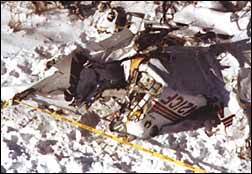Jan. 8, 2000
BY DAVID GRANT LONG The body of a Montrose businessman was found near his badly demolished plane Thursday afternoon after the strewn wreckage was spotted from the air during the second day of an intensive search in the snow-covered San Juan Mountains north of Dolores. Clarence Brasier, 53, died instantly from the impact when his twin-engine Cessna 421 smashed into a ridge a few miles west of Groundhog Reservoir near South Mountain, according to Dolores County Sheriff Jerry Martin. The plane had taken off from the Montrose airport Sunday morning and disappeared from Denver radar about an hour later, Martin explained, plunging about 4,000 feet in 14 seconds; but because Brasier, an experienced pilot, had filed no flight plan with the Federal Aviation Agency, a search was not initiated until his family reported him missing Tuesday afternoon. The victim, who operated a paving business, had been headed for Santa Teresa in southern New Mexico on a business trip, he said. The wreckage was spotted at 12:45 p.m. from a high-altitude Colorado National Guard helicopter, Martin said, and a ground crew arrived at the site by snowmobile a little more than an hour later. Brasier’s body was finally located near the disintegrated craft at about 4:30 p.m.. "He hit a ridge on the edge of South Mountain and then plummeted on down the hill," Martin recounted. "(The wreckage) was strung out over an eighth of a mile —it was completely demolished. "I’ve been told also that there was an intense snowstorm in that area at the time the crash occurred," he added. Although the specific cause of the accident is still under investigation, Martin said there was speculation that Brasier may have been flying under automatic control when the aircraft began its precipitous descent. "One of the possibilities that was thrown out from the pilots — and I discussed it with his son also — was that he flew on automatic pilot quite a bit," he said. "They suggested that when he hit some turbulence in the storm the automatic pilot shut off and that was the point when he lost control of the airplane and never was able to regain it. "But that’s just a theory." The radar readout shows that the victim may also have become confused about his location after encountering the storm, according to Martin. "There’s some indication that he was making some real sharp turns," he said. "It looked like he apparently got disoriented, because from the point of the crash, he was a little bit east of where they were tracking him" before the plane went below radar. Investigators from the National Transportation Safety Board, the FAA and the insurance carrier were at the scene yesterday, Martin said, and should be able to provide more information about the crash soon. "They’re going to get all they can see from the scene and make a determination whether they’re going to remove the aircraft at this time or wait until accessibility is a little better," he said. Volunteer pilots and spotters with the Colorado Civil Air Patrol had five planes in the air Wednesday and local volunteers on snowmobiles initiated a ground search in the area Thursday morning. Brasier’s family also had hired two private helicopters to search. However, the plane’s color scheme —white with a red stripe — made it extremely difficult to spot in the snow-blanketed terrain. Brasier was reportedly a native of the area who was born in Norwood, according to the Norwood Post. His survivors include a wife, according to Martin, who had no other information about the family. |
||
Copyright © 2000 the Cortez Journal. All rights
reserved. |
